Are Wormholes Real? Mysterious Portals of the Universe
11th Apr 2024
Jumping into wormholes to travel through space and time is common in science fiction. Remember how the astronauts in the Interstellar space movie travel great distances in a matter of minutes? It looks fantastic, but what if we told you that scientists suggest such journeys could be real?
Are wormholes real? Or are they just another unproven scientific hypothesis? We collected everything we knew about wormholes and even a bit more and created this wormhole 101 for you. So, let’s go on a journey through these mysterious portals of the Universe.
What Is a Wormhole?
A wormhole (or warp hole) in physics is a hypothetical tunnel through the space-time continuum that allows one to connect two points in the Universe or two different Universes, significantly reducing the time it takes to travel from one point to another.

To visualise how wormholes are formed, take a sheet of paper and draw two distant points on one side. Now, the sheet is a two-dimensional space, a plane, and two points are the distance we must overcome. But we live in three-dimensional space, and according to Einstein’s theory of relativity, it is curved under the influence of mass and energy.
Fold the paper sheet so that the two points touch, and you will see that the distance between them was reduced to a minimum. You can “bypass” from one point to another, that is, by going around the sheet, or you can pierce the paper with a pencil as if connecting the dots with a “tunnel”. Congratulations! We have just built a baby wormhole prototype. In fact, a wormhole can be considered a variation of a time travel machine. For example, you can exit a tunnel before you enter it, while decades may pass for observers outside the tunnel.
Where Did the Name “Wormhole” Come From?
Such an unusual name for space-time holes was coined by the American physicist John Archibald Wheeler in 1957; before that, they were simply called canals or bridges. Why a wormhole? The scientist was inspired by the example of an apple with a wormhole and an ant crawling on its surface. To get to the other side of the apple, the ant can either crawl “in its own universe”— on the surface of the apple — or crawl through the passage made by the worm.
That same year, in a joint paper written with his colleague Charles W. Misner and published in the scientific journal Annals of Physics, Wheeler wrote: This analysis forces one to consider situations […] where there is a net flux of lines of force, through what topologists would call “a handle” of the multiply-connected space, and what physicists might be excused for more vividly terming a “wormhole”.

By the way, John Wheeler also coined the terms “black hole” and “quantum foam” (a hypothetical subatomic substance that is a billion trillion times smaller than the nucleus of an atom, exists in space, and can act as material for wormholes). But if the existence of a black hole is proven, wormholes and quantum foam remain hypothetical models.
Are Wormholes a Myth?
No, but it’s complicated. In the entire history of the wormhole theory, such tunnels in space-time have never been observed, either directly or indirectly. However, their existence is mathematically predicted by solutions to the gravitational field equations that underlie the general theory of relativity. These solutions do not guarantee that wormholes actually exist in nature; they only show that they do not contradict the laws of gravity.
Now is the right time to recall the famous Fermi Paradox, which casts doubt on the existence of alien civilisations. Fermi asks – if there should be many advanced civilisations in our galaxy, where are they? In relation to the wormhole theory, we can rephrase: if wormholes exist, why haven’t we seen them yet?
Who Came Up With the Idea of Wormholes?
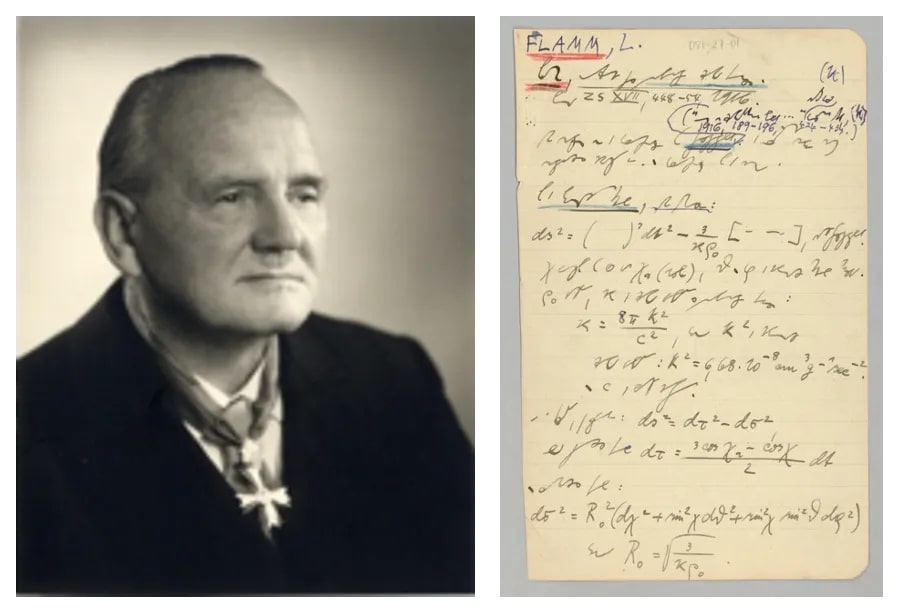
Credit: historicpittsburgh.org
Austrian physicist Ludwig Flamm is considered to be the discoverer of wormholes. In 1916, a year after Einstein formulated the laws of general relativity, German physicist and astronomer Karl Schwarzschild proposed an exact solution to Einstein’s equations, describing the gravitational field of a static and symmetric black hole. While studying the Schwarzschild metric, Flamm noticed another solution was possible, describing the phenomenon that later became known as the “white hole.” Black and white holes are objects in the Universe that are complete opposites of each other. Nothing can leave the event horizon of a black hole, but nothing can penetrate the event horizon of a white hole.
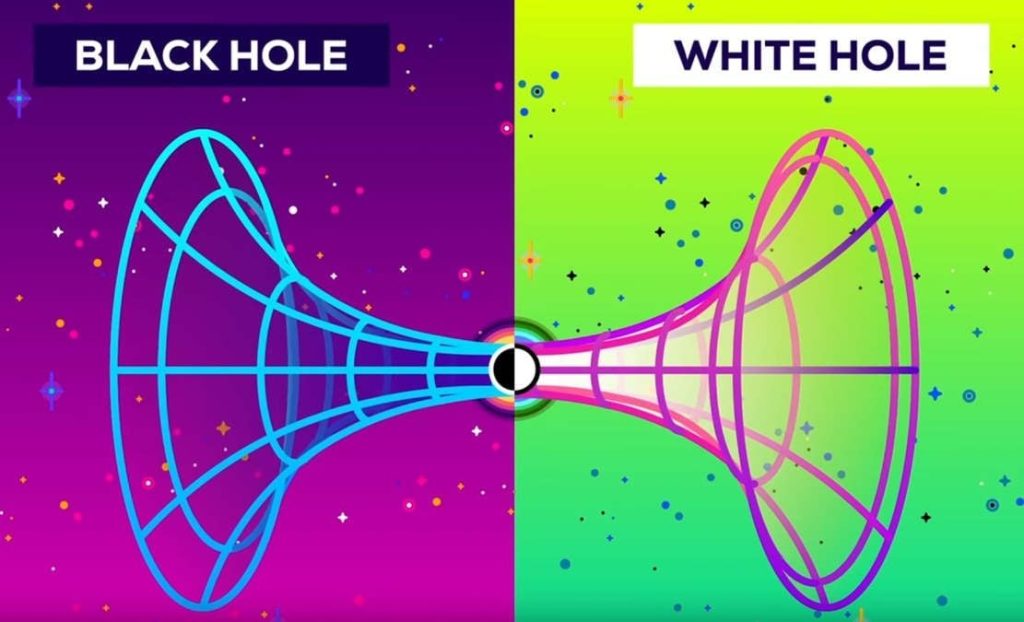
Flamm suggested that a space-time channel could mathematically connect the entrances of black and white holes with a spherical neck without the gravitating matter. The scientist published his inventions in the 1916 article Comments on Einstein’s Theory of Gravitation, but the scientific community unfairly ignored his bold ideas.
What Did Einstein Say About Wormholes?
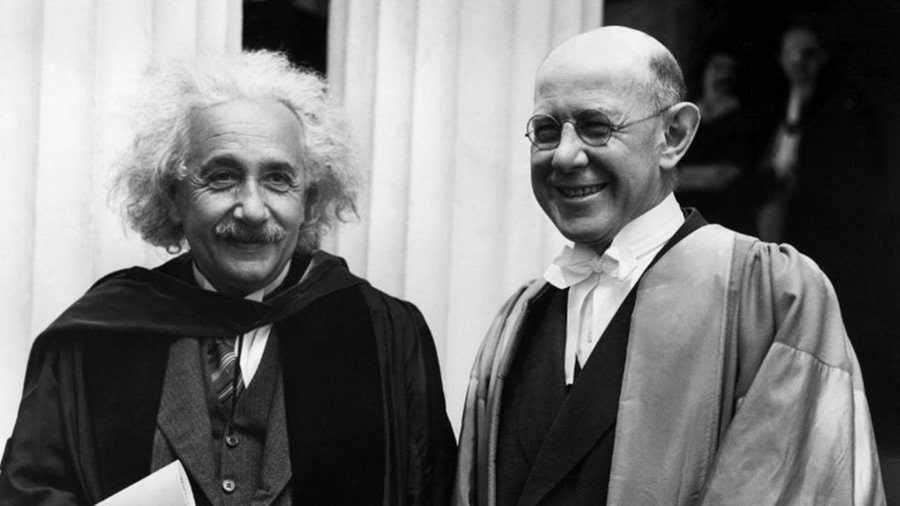
In 1935, Einstein, along with his colleague Nathan Rosen, in an attempt to combine gravity with electromagnetism and get rid of the singularities of the Schwarzschild solution, actually rediscovered the Flamm wormhole. Knowing nothing about Flamm’s work, they arrived at a similar solution to the equations of relativity, describing the wormhole as a bridge between the two interior regions of a black and white hole, which lie in two different universes, so it was dubbed the “Einstein-Rosen bridge.”
Later, when John Wheeler coined the term “wormhole,” the Einstein-Rosen bridge also became known as the “Schwarzschild wormhole” since its idea is based on an extended version of the Schwarzschild metric, in which a tunnel is not static, but is born from a singularity, expands, and then collapses. The picture below shows what it looks like.
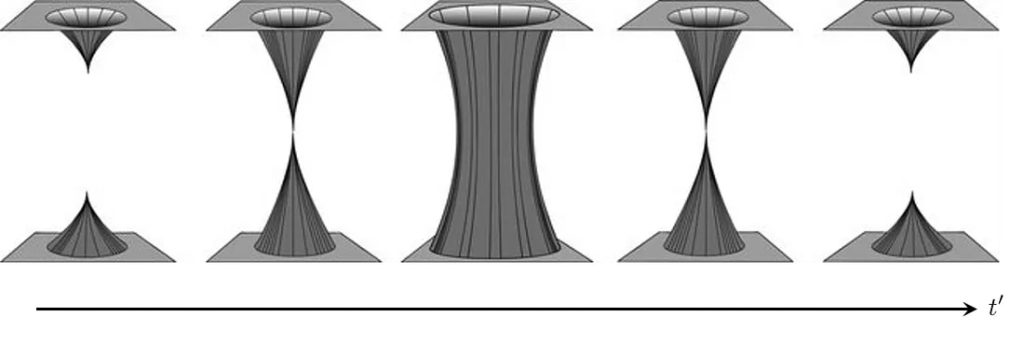
What Are the 3 Types of Wormholes?
Scientists have been working on the wormhole theory for more than a hundred years, but the issue is still far from being fully explored. Today, space-time tunnels can be divided into three groups, but the list may be expanded in the future.
- Non-traversable/traversable wormholes.
- One-way/two-way wormholes.
- Intra-Universe/Inter-Universe wormholes.
Through traversable wormholes, one can travel freely. Non-traversable tunnels do not provide this opportunity since they are either unstable (quickly collapse or kill particles entering them) or have an entrance but no exit.
A one-way tunnel involves travelling only one way, and to get back, you will need to look for another passage. Intra-Universe channels are located in our universe, and Inter-Universe channels connect our universe with another parallel universe.
Theoretically, wormholes can combine different types of properties. For example, a one-way hole may be passable or impassable. And Inter-Universe passage can be one-way or two-way. Two-way traversable Intra-Universe tunnel is the most common type in science fiction. It was through such wormholes that the Interstellar movie characters travelled.
Can We Actually Travel Through Wormholes?
Unfortunately, in 1962, John Wheeler showed that the Schwarzschild wormhole, if it connects parts of the same universe, is impenetrable because it opens and closes too quickly for the travellers to cross. Even if we assume that you manage to enter such a tunnel, you will not be able to exit it. Tidal forces will kill you quickly.
Only 24 years later, in 1986, the American physicist Kip Thorne proposed the first solution to Einstein’s equations with a traversable hole. He filled the space-time tunnel with exotic matter, a substance with negative mass that is not attracted but is repelled due to gravity, thus preventing the hole from collapsing.
Thorne’s model inspired the science behind the Interstellar movie. Its only flaw is that exotic matter has not yet been discovered in nature. Thanks to the strange laws of quantum physics, it can be obtained in very small quantities in lab conditions between two closely spaced electrically conductive plates. This is called the Casimir effect, named after the Dutch physicist Hendrik Casimir. But this amount is too small to prevent real wormholes from collapsing.
Where can one get so much exotic matter? It may be abundantly present in dark matter. However, another problem is that dark matter is also currently unavailable to us and remains hypothetical. However, the existence of black holes had not been proven until very recently, so let’s not despair and stay patient.
How to Create a Wormhole?
Of course, if we could find or create artificial wormholes and control them, the travel through space and time like Cooper did in Interstellar could become a reality. But how to do that? Is it possible to create a real wormhole? One way is to remove the hole from quantum foam (if it exists), expand it to a large scale and fill it with exotic matter that will prevent the tunnel from collapsing. Unfortunately, in practice, this will not be possible for a long time, based on the circumstances and technologies that we have. But there may be a loophole.
Cornell Scientists And Warped Passages Theory
In 2022, a group of physicists from Cornell University published a study suggesting the possibility of creating an artificial wormhole, provided that the Universe has more than three dimensions. Besides, according to scientists, exotic matter becomes unnecessary in this case.
The hypothesis is based on the theory of Warped passages, proposed by physicists Lisa Randall and Raman Sundrum in 1999. Randall-Sundrum’s theory suggests that our three-dimensional universe is a brane (a high-dimensional object that can connect different points in space or even different universes). This brane is immersed in a bulk consisting of at least 5, but probably 10–11 dimensions, of which only 4 can be perceived by humans. Gravity can propagate throughout the bulk, but other fundamental forces can only propagate throughout the brane. This may explain the weakness of gravity compared to other forces. In theory, gravity could be quite strong, but it is so heavily diluted by the extra dimensions in the bulk that it appears weak to our three-dimensional experience.
Warped passages theory is inspired by the String theory, which also proposes the existence of extra dimensions compressed or warped to microscales and views wormholes as string objects that can connect different branes or universes.
Remember how at the end of Interstellar, Cooper ends up inside the Tesseract (the gravitational singularity of the warp hole). The Tesseract translates the fifth dimension into three-dimensional visibility (tuned to Murph’s room in the past). It allows Cooper to carefully manipulate the hands of Murph’s watch, transmitting data as Morse code. He texts “STAY” while pushing books off Murph’s shelf and transmits the map coordinates to a previous version of himself in binary, spilling dust from the shelf onto the floor. Having managed to decipher Cooper’s messages, Murph receives all the information she needs to improve humanity’s understanding of space and time radically and gain the ability to use fifth-dimensional physics, in particular gravity.
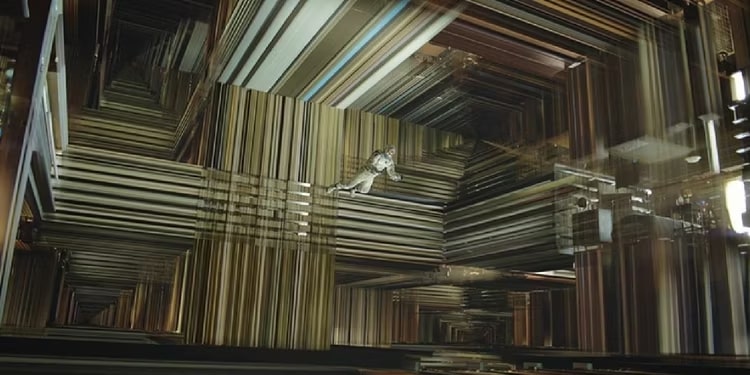
The Baby Wormhole Project
Also in 2022, another group of scientists, this time from the California Institute of Technology and the leading US particle physics and accelerator laboratory Fermilab, created a holographic simulation of a warp hole using the Google Sycamore quantum computer housed at Google Quantum AI in Santa Barbara. The results of this study were published in the journal Nature.
Scientists used the Sycamore quantum processor to create two tiny black holes and send a message between them through quantum entanglement, which is a phenomenon that links two particles in such a way that the measurement of one instantly affects the other. The researchers discovered that quantum information teleported between black holes had the characteristics of a traversable quantum wormhole. However, they also clarified that no real warp hole was physically created in this experiment and that the simulation was based on a simplified model that did not include gravity or other physical effects.
The Road Is Made By Walking
No one has yet been able to prove or disprove the existence of wormholes. But one thing is certain: every new attempt is a valuable result, bringing us closer to a better understanding of the Universe and our place in it. The main thing is to know that the road is passable.
Wormholes FAQ
And while scientists continue to ponder are wormholes real, let’s find out the answers to frequently asked questions about these mysterious portals in the Universe.
Can Wormholes Exist?
Theoretically, yes. The equations of Einstein’s general theory of relativity allow for the existence of wormholes as one possible solution. However, this does not mean that such holes actually exist in reality. Specific conditions are necessary for wormholes to be stable and traversable, such as the presence of exotic matter that can resist gravity and keep the neck of the warp hole open. Such matter or energy has not been found in nature.
Have Wormholes Been Proved?
No. To date, there is no reliable evidence of the real existence of space-time tunnels. Everything we know about wormholes is based on theoretical calculations and computer models. However, scientists at NASA and other space agencies and institutes are trying to find their traces in space using various observation methods such as gravitational waves, gravitational lenses, gamma-ray bursts and others.
Are Wormholes Possible on Earth?
Most likely, no. Creating a warp hole requires extreme gravitational conditions, such as those near supermassive black holes at the centres of galaxies. Simply put, we would need a black hole on Earth, and this is physically unattainable. To create a black hole just a centimetre in size, we would need to crush a mass roughly equal to the mass of the Earth to such a tiny size.
Is It Possible to Go into a Wormhole?
Theoretically, yes. If we found or created a traversable warp hole, we could try to enter it and go to another place or time. However, this would be very risky since we don’t know where the wormholes will take you and what physical forces are at work inside the tunnel. We could encounter heat, radiation, gravitational waves, anomalous fields, and other dangers that could destroy us or damage our ship. Plus, we don’t know how stable the warp hole is or whether it will close once we’re inside.
Could a Human Survive a Wormhole?
It depends on what kind of wormhole we’re facing. If it is a non-traversable Einstein-Rosen warp hole, then the chances of survival are negligible since, in order to enter it, you need to cross the event horizon of the black hole, which means you can never go back. In addition, you most likely will not live to exit the warp hole, as you will be torn apart by the tidal forces and compressed into an infinitesimal point – a singularity. If it is a traversable Morris-Thorne warp hole made of exotic matter, then the chances of survival are high since the gravitational forces inside the tunnel will be small, and you will be able to pass through it without any difficulty. However, you still risk encountering unknown dangers at the other end of the tunnel or being trapped if the warp hole suddenly collapses.
Could a Wormhole Go Back in Time?
Theoretically, yes. If we were to find or create a warp hole that connects two points in the same universe but in different times, then we could use it to travel to the past or the future. Such a warp hole is called a time loop. You can move along such a curve in any direction and return to the starting point. However, time travel through a wormhole faces a number of paradoxes. In addition, it is unknown how stable the time loop is and whether it will collapse under the influence of quantum fluctuations or feedback.
References and Additional Information:
- The Particle Problem in the General Theory of Relativity
https://www.semanticscholar.org/paper/The-Particle-Problem-in-the-General-Theory-of-Einstein-Rosen/17bba85d420d075700cf3e7fef6d9934f5aa9ec3?p2df
- The Physics of Wormholes
https://medium.com/swlh/the-physics-of-wormholes-654facefd2ea
- Wormhole: Learn its Theory, Types, & Formation
https://testbook.com/physics/wormhole
- Wormholes in spacetime and their use for interstellar travel: A tool for teaching general relativity
https://pubs.aip.org/aapt/ajp/article-abstract/56/5/395/1044276/Wormholes-in-spacetime-and-their-use-for






Thank you for your comment! It will be visible on the site after moderation.